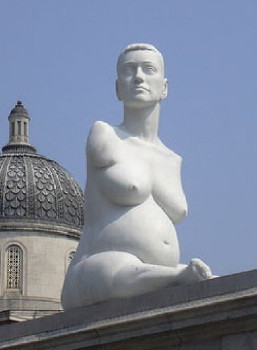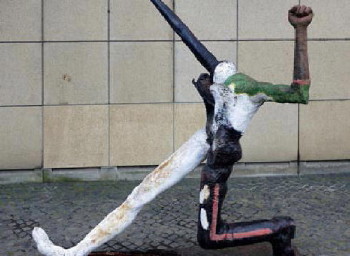Artist:
Markus Lüpertz
Title:
Der gestürzte Krieger (The Fallen Warrior)
Year:
1994
Adress:
Kantstrasse 156
Last moment of a brave man
With Der Gestürzte Krieger by Markus Lüpertz we witness the last moment of a brave man who has fought for a good cause. The materialization is shocking; the person already appears to fall apart.
By Theo, www.artatsite.com
Compared with other works
Nothing wrong; Europe Power Handstand. Ernst Leonhard's (Berlin, picture 1, more information) work plays catchy way with a heavy body that adopts a onwaarschijlijke attitude.
The artwork Allison Lapper Pregnant by Marc Quinn (London, picture 2, more information) is contradictory: a flawed body is performed in one of the finest materials, made a human deficit exhibited no single gene. It is logical that this evokes a fierce resistance in many people. This artwork is a masterpiece by the perfect execution and lifelike expression and fundamental discussions it evokes.
Although Yolanda by Miriam Lenk (Berlin, picture 3, more information) does not have the perfect buddies, she is so attractive that it's hilarious.
Wolfgang Matteuer's Jahrhunderschritt (Berlin, picture 4, more information) depicts a person off which does not correspond to the ideal of beauty. This person makes an incredibly big step forward and is apparently incredibly strong. Wolfgang Matt Heuer knows Jahhundertschritt ('One Hundred Years Step', Berlin) to portray a convincing person without the use of perfect shapes, proportions and colors.
Although Karl Bobek's Torso (Berlin, picture 5, more information) of a man impersonates who is actively involved, the man also seems to perish. This man confronts effectively serious issues of life and mortality.
It is so painful to walk through an intimate space of two lovers who are totally vulnerable meeting. Maybe the people of Wohin Gehst Du by Andreas Wegner (Berlin, picture 6, more information), experience their last moments together.
By Theo, www.artatsite.com
www.wikipedia.org:
Markus Lüpertz (born 25 April 1941) is a German painter, sculptor, graphic artist, and writer. He also publishes a magazine, and plays jazz piano. He is one of the best-known German contemporary artists. His subjects are characterized by suggestive power and archaic monumentality. Lüpertz insists on capturing the object of representation with an archetypal statement of his existence. His art work is associated to neo-expressionism. Known for his eccentricity, German press has stylized him as a "painter prince".
Lüpertz has cultivated sculpture and designed stage sets since 1980. Among his most famous works are the figure of Apollo for a niche in the Alte Oper in Frankfurt, from 1989, the bridge sculpture The Ugly Scares the Beauty (1990), in Karlsruhe, The Fallen Warrior, a three meters long bronze sculpture of a fallen warrior with helmet and shield, inspired by an ancient Greek sculpture, in the Berlin Kantstrasse, an ensemble of three sculptures for the park of Schloss Bensberg (2000), The Philosopher, a bronze nude sculpture created for the foyer of the new Berlin Chancellery, in 2001, and a sculpture of Apollo, inaugurated in the Elisabethenplatz in Bamberg, in 2009.
www.bildhauerei-in-berlin.de:
Der Berlinischen Galerie bereits 1987 gestiftet. Fertigstellung des Gebäudes 1992, Aufstellung der Plastik 1995. Lüpertz bezieht sich mit seinem "Tod des Kriegers" deutlich auf Henry Moores "Warrior" in Goslar von 1973-1974, den der Künster anlässlich seiner Verleihung des Goslar-Rings giessen ließ. Der archäologisch bewanderte Betrachter fühlt sich an antike Vasenmalerei und an Giebelfiguren griechisch-antiker Tempel erinnert, etwa den Tempel der Aphaia auf der Insel Ägina (so genannte Ägineten), dessen kostbare Marmorskulpturen in der Münchner Glyptothek (Antikensammlung) aufbewahrt werden.
Translation:
The berlinische Galerie already established in 1987. Completion of the building in 1992, and a list of plastic in 1995. Lüpertz refers to his "death of the warrior" clearly on Henry Moore's "Warrior" in Goslar from 1973-1974, as the artist had on the occasion of his award of the Goslar-ring pour. The archaeologically minded viewer feels ancient vase painting and pediment figures in Greek-ancient temple reminded about the temple of Aphaia on the island of Aegina (so-called Ägineten), whose precious marble sculptures are kept in the Munich Glyptothek (antique collection).
Text: Marc Wellmann, Jörg Kuhn.
With Der Gestürzte Krieger by Markus Lüpertz we witness the last moment of a brave man who has fought for a good cause. The materialization is shocking; the person already appears to fall apart.
By Theo, www.artatsite.com
Compared with other works
Nothing wrong; Europe Power Handstand. Ernst Leonhard's (Berlin, picture 1, more information) work plays catchy way with a heavy body that adopts a onwaarschijlijke attitude.
The artwork Allison Lapper Pregnant by Marc Quinn (London, picture 2, more information) is contradictory: a flawed body is performed in one of the finest materials, made a human deficit exhibited no single gene. It is logical that this evokes a fierce resistance in many people. This artwork is a masterpiece by the perfect execution and lifelike expression and fundamental discussions it evokes.
Although Yolanda by Miriam Lenk (Berlin, picture 3, more information) does not have the perfect buddies, she is so attractive that it's hilarious.
Wolfgang Matteuer's Jahrhunderschritt (Berlin, picture 4, more information) depicts a person off which does not correspond to the ideal of beauty. This person makes an incredibly big step forward and is apparently incredibly strong. Wolfgang Matt Heuer knows Jahhundertschritt ('One Hundred Years Step', Berlin) to portray a convincing person without the use of perfect shapes, proportions and colors.
Although Karl Bobek's Torso (Berlin, picture 5, more information) of a man impersonates who is actively involved, the man also seems to perish. This man confronts effectively serious issues of life and mortality.
It is so painful to walk through an intimate space of two lovers who are totally vulnerable meeting. Maybe the people of Wohin Gehst Du by Andreas Wegner (Berlin, picture 6, more information), experience their last moments together.
By Theo, www.artatsite.com
www.wikipedia.org:
Markus Lüpertz (born 25 April 1941) is a German painter, sculptor, graphic artist, and writer. He also publishes a magazine, and plays jazz piano. He is one of the best-known German contemporary artists. His subjects are characterized by suggestive power and archaic monumentality. Lüpertz insists on capturing the object of representation with an archetypal statement of his existence. His art work is associated to neo-expressionism. Known for his eccentricity, German press has stylized him as a "painter prince".
Lüpertz has cultivated sculpture and designed stage sets since 1980. Among his most famous works are the figure of Apollo for a niche in the Alte Oper in Frankfurt, from 1989, the bridge sculpture The Ugly Scares the Beauty (1990), in Karlsruhe, The Fallen Warrior, a three meters long bronze sculpture of a fallen warrior with helmet and shield, inspired by an ancient Greek sculpture, in the Berlin Kantstrasse, an ensemble of three sculptures for the park of Schloss Bensberg (2000), The Philosopher, a bronze nude sculpture created for the foyer of the new Berlin Chancellery, in 2001, and a sculpture of Apollo, inaugurated in the Elisabethenplatz in Bamberg, in 2009.
www.bildhauerei-in-berlin.de:
Der Berlinischen Galerie bereits 1987 gestiftet. Fertigstellung des Gebäudes 1992, Aufstellung der Plastik 1995. Lüpertz bezieht sich mit seinem "Tod des Kriegers" deutlich auf Henry Moores "Warrior" in Goslar von 1973-1974, den der Künster anlässlich seiner Verleihung des Goslar-Rings giessen ließ. Der archäologisch bewanderte Betrachter fühlt sich an antike Vasenmalerei und an Giebelfiguren griechisch-antiker Tempel erinnert, etwa den Tempel der Aphaia auf der Insel Ägina (so genannte Ägineten), dessen kostbare Marmorskulpturen in der Münchner Glyptothek (Antikensammlung) aufbewahrt werden.
Translation:
The berlinische Galerie already established in 1987. Completion of the building in 1992, and a list of plastic in 1995. Lüpertz refers to his "death of the warrior" clearly on Henry Moore's "Warrior" in Goslar from 1973-1974, as the artist had on the occasion of his award of the Goslar-ring pour. The archaeologically minded viewer feels ancient vase painting and pediment figures in Greek-ancient temple reminded about the temple of Aphaia on the island of Aegina (so-called Ägineten), whose precious marble sculptures are kept in the Munich Glyptothek (antique collection).
Text: Marc Wellmann, Jörg Kuhn.









